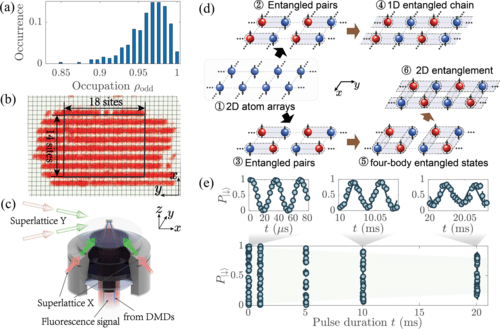Scientists in China have made a significant breakthrough in developing quantum computers. The team, led by Pan Jianwei from the University of Science and Technology of China, has successfully entangled multiple ultracold atoms in a laser trap.
This is a crucial step towards scalable quantum computation and simulation. Previously, only two atoms could be entangled simultaneously, but the team has developed new methods to link eight and 10 bits. This could lead to much faster and more powerful computers. The team has been studying optical-lattice-based ultracold atomic systems since 2010 and has achieved entanglement of more than 1,000 pairs of rubidium atoms in previous experiments. However, this new study has allowed them to create and verify the entanglement of multiple atoms at single-atom resolution.
Scientists from the University of Science and Technology of China, Tsinghua University and Fudan University, led by Pan Jianwei, have made a significant breakthrough in quantum computing. They have developed new methods and devices to entangle eight and 10 atoms, a crucial step towards large-scale atom entanglement. This could lead to much faster and more powerful computers. The team used optical lattices to trap atoms and achieved the entanglement of over 1,000 pairs of rubidium atoms. Their new study offers a platform towards scalable quantum computation and simulation.
Push for Quantum China
Scientists from the University of Science and Technology of China (USTC), Tsinghua University and Fudan University have made significant advancements in quantum computing. Their research, published in the peer-reviewed journal Physical Review Letters, offers a new platform towards scalable quantum computation and simulation. The team has developed new experimental devices and methods to link eight and ten atoms in two-dimensional blocks and one-dimensional chains, respectively. This marks a crucial step towards preparing and manipulating large-scale atom entanglement.
The Challenge of Atom Entanglement
One of the main challenges in quantum computing is the entanglement of multiple atoms. Scientists have been using a device known as optical lattices, which are webs of laser beams for trapping atoms, as a promising platform for quantum computers. However, they have struggled to entangle more than two atoms at a time to allow scalability. The team at USTC has been studying optical-lattice-based ultracold atomic systems since 2010, and they have achieved entanglement of more than 1,000 pairs of rubidium atoms in previous experiments.
To overcome the challenge of multi-atom entanglement, the team developed a number of new instruments and technologies. These include an optical superlattice, a quantum gas microscope and three digital micromirror devices. These tools allowed them to create and verify the entanglement of multiple atoms at single-atom resolution. Using about 100 ultracold rubidium atoms, they were able to make entangled pairs with a fidelity of over 95 per cent and more than a two-second lifetime.
The team’s experiment showed essential ingredients in the road map towards generating multipartite entangled states. The “building blocks” of entangled groups opened the revenue to larger scale, practical quantum computing. This breakthrough in entangling multiple atoms in a laser trap is a significant step towards developing practical processors for quantum computers.
“The study offered “a new platform towards scalable quantum computation and simulation,” wrote Pan Jianwei and his colleagues from the University of Science and Technology of China (USTC), Tsinghua University and Fudan University in their paper published in the peer-reviewed journal Physical Review Letters last month.
“Their experiment showed essential ingredients in the road map towards generating multipartite entangled states, and the “building blocks” of entangled groups opened the revenue to larger scale, practical quantum computing,”
Brief Summary
Chinese scientists have significantly advanced quantum computing by successfully entangling multiple ultracold atoms in a laser trap, a crucial step towards developing practical quantum processors. This breakthrough, which involved linking eight and 10 atoms in two-dimensional blocks and one-dimensional chains, could pave the way for faster and more powerful computers.”
- Scientists from the University of Science and Technology of China (USTC), Tsinghua University and Fudan University, including Pan Jianwei, have made a significant breakthrough in quantum computing.
- The team has developed new experimental devices and methods to entangle eight and 10 atoms at a time, a crucial step towards scalable quantum computation and simulation.
- This achievement surpasses previous studies that could only entangle two atoms at a time.
- The entanglement of multiple ultracold atoms in a laser trap could pave the way for the development of practical processors for quantum computers.
- The team used a device known as optical lattices, webs of laser beams for trapping atoms, to achieve this.
- They have been studying optical-lattice-based ultracold atomic systems since 2010 and have previously achieved entanglement of more than 1,000 pairs of rubidium atoms.
- The new study involved the development of new instruments and technologies, including an optical superlattice, a quantum gas microscope and three digital micromirror devices.
- Using about 100 ultracold rubidium atoms, they achieved entangled pairs with a fidelity of over 95 per cent and more than two-second lifetime.

